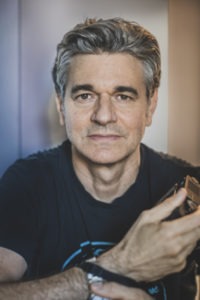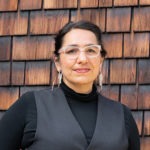We regret to announce that the event “BRINK: Photographs by David Butow” scheduled for March 11, 2022 has been cancelled.
Join us for a live conversation with photographer David Butow and Berkeley Journalism Prof. Ken Light, followed by Q&A with Berkeley Journalism students Kathryn Styer Martínez (’23) and Mathew Miranda (’22)
 David Butow has been a professional photojournalist since the 1980’s. His pictures have appeared in many publications around the world including National Geographic, TIME and Paris Match. His past work includes the 1992 Los Angeles Riots, the 2003 invasion of Iraq, and the 2019 democracy demonstrations in Hong Kong. He has worked in dozens of countries and received awards from World Press Photo, Pictures of the Year International, Communications Arts and others.
David Butow has been a professional photojournalist since the 1980’s. His pictures have appeared in many publications around the world including National Geographic, TIME and Paris Match. His past work includes the 1992 Los Angeles Riots, the 2003 invasion of Iraq, and the 2019 democracy demonstrations in Hong Kong. He has worked in dozens of countries and received awards from World Press Photo, Pictures of the Year International, Communications Arts and others.
Statement from David Butow:
A few weeks before the 2016 presidential election, I traveled to the swing states of the upper Midwest to try to get a sense of what was driving support for Donald Trump. I fully expected Hillary Clinton to win but Trump had tapped into something I didn’t understand, and I was surprised that this self-centered, unscrupulous businessman who seemed to have no interest in government, was the Republican nominee.
His stunning victory, and the sense that the country would go through a very strange period, compelled me to move from California to Washington, D.C. I’d spent decades as a photojournalist covering, in part, the results of public policy, but I’d never worked inside the halls of power in the nation’s capital. This seemed like a good time to do it, and while I expected the incompetence, I underestimated the treachery.
The first three years were an endless stream of scandals, highly-charged congressional hearings on Capitol Hill and declassé press events at the White House. I was curious what happened outside of the frame of television cameras and tried to make photographs that were different from typical pictures designed for the daily news cycle and quick hits on the web.
In 2020, everything changed. The drama and tension was acute, and visceral. Americans were dying of COVID-19 by the thousands, the administration was slow to respond and protests of the murder of George Floyd pressed up to the very gates of the White House. Late in the year, after Joe Biden’s victory, the president and his hard-core supporters laid the groundwork for challenging the election.
On the afternoon of January 6, 2021 I was standing on the west steps of the Capitol watching something so surreal, dramatic and terrible, for a few seconds, or maybe it was minutes, I lowered my camera and just tried to process what I was seeing through the foggy view of my gas mask. The next few weeks at the Capitol were unrecognizable, as young National Guard troops carrying loaded machine guns stood on patrol behind miles of razor wire, protecting U.S. democracy from its own citizens.
It was then that I knew I must organize the work I’d begun four years earlier into a narrative that would at least illuminate the arc of events that had brought the country to this point. We lived through history minute by minute, so much so that the gravitas of what transpired is apparent only when you step back and see how the whole saga unfolded. As revisionists seek to trivialize or downplay the events of 2016-21, it’s critical to maintain a record of just how close the presidency of Donald Trump brought U.S. democracy to the brink of collapse.
Four years ago, I thought this period would be an aberration. Regrettably, I no longer hold that view.
 Ken Light has worked as a documentary photographer, focusing on social issues facing America for over 50 years. He is the Reva and David Logan Professor of Photojournalism and curator of the Center for Photography at Berkeley Journalism.
Ken Light has worked as a documentary photographer, focusing on social issues facing America for over 50 years. He is the Reva and David Logan Professor of Photojournalism and curator of the Center for Photography at Berkeley Journalism.
 Kathryn Styer Martínez (’23) is a Northern Californian multimedia journalist. Her reporting focuses on Latino communities, economic equity and solutions to social problems.
Kathryn Styer Martínez (’23) is a Northern Californian multimedia journalist. Her reporting focuses on Latino communities, economic equity and solutions to social problems.
 Mathew Miranda (’22) is a journalist and photographer whose work has mostly focused on Latino communities, homelessness and sports. He is the 2021 Jim Marshall Fellow in Photography at Berkeley Journalism.
Mathew Miranda (’22) is a journalist and photographer whose work has mostly focused on Latino communities, homelessness and sports. He is the 2021 Jim Marshall Fellow in Photography at Berkeley Journalism.
How to support the next generation
In 2015, the J-School’s Center for Photography joined with photographer Jim Marshall’s estate to launch the Jim Marshall Fellowships in Photography. Our goal is to raise $500,000 to $1,000,000 in funds dedicated to supporting the visual arts at the School. We’re depending on people like you to reach this ambitious goal in tax-deductible donations both large and small. Donate online today at: http://givetocal.berkeley.edu/jimmarshallfellowships.
LOCATION
Online
SPECIAL INSTRUCTIONS
LIVESTREAMED EVENT:
https://youtu.be/7uUVql_0Kmo
Friday, March 11, 2022 | 5:00-6:00 PM (PT)
TICKET INFO
This is a FREE event.
Tax-deductible donations from the J-School community help make this possible.
No tickets required
